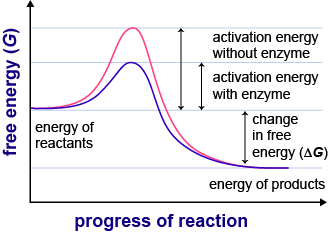- Enzyme Action -
Enzymes are important in everyday life, without us realising it. They assist us in respiration, metabolic reactions, digestion, etc.. They are an important in serving a wide range of important functions in the body.
Enzymes = Globular proteins // Acts as catalysts.
So how do enzymes as a, catalysts, lower the activation energy?
For enzymes to assist in a chemical reaction there would need to be activation energy.
Activation energy = the minimum quantity of energy which the species must have in order to undergo with the specific reaction.
Enzymes allow reactions to occur at lower temperatures than normal - this is a result of the enzyme lowering the activation energy.
For example - some metabolic processes occur at the human body temperature of 37℃ ⇒ this is relatively low for a chemical reaction.
Without enzymes, reactions would proceed too slowly to sustain life.
What is the structure of an enzyme?
A specific region of the enzyme is classed as functional - active site.
The active site is made up of small number of amino acids. Within the much large enzyme the active site would leave a small depression to allow the substrate to fit.
The substrate is the molecule which the enzyme acts on. When the substrate fits into the depression it forms an enzyme-substrate complex. This is held by bonds that is temporarily formed between the certain amino acids on the active site and groups on the substrate molecule.
Induced fit model of enzyme action.
Induced fit model is a more recent model developed, that is both widely accepted and has evidence to back it up.
The model states that the active site of the enzyme is not exactly complementary to the substrate. However, in the presence of a specific substrate the shape of the active site would change slightly in order to become complementary.
In other words, the enzyme is flexible and is able to mould itself around the substrate like a glove moulds itself around a hand.
The Lock and Key model -
This was a much earlier model explaining the enzyme action. Suggesting enzyme action was the same as a lock and key. Each lock has a specific key, the key would only operate and unlock the specific lock.
This implies that the substrate shape is specific to the active site and has an exact fit.
A limitation of this would be that the model considers the enzyme as a rigid structure, but as it was found other molecules could bind to the enzyme at sites that was not the active site. As a result of this the enzyme structure was being altered.
The structure was not rigid but flexible.





No comments:
Post a Comment